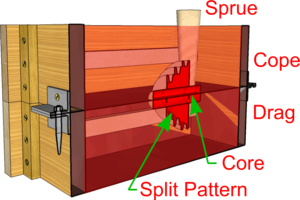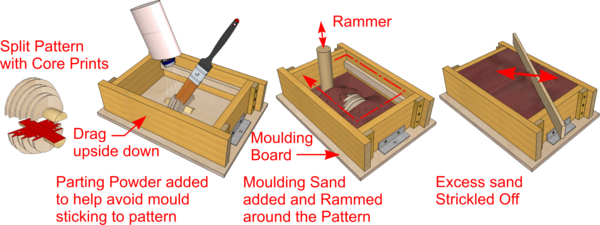Sand Casting: Difference between revisions
From DT Online
No edit summary |
mNo edit summary |
||
| Line 31: | Line 31: | ||
* The half of the [https://en.wikipedia.org/wiki/Pattern_(casting) '''Pattern'''] without location pegs, is placed on the '''Moulding Board''' and the '''Drag''' positioned upside down around it. | * The half of the [https://en.wikipedia.org/wiki/Pattern_(casting) '''Pattern'''] without location pegs, is placed on the '''Moulding Board''' and the '''Drag''' positioned upside down around it. | ||
* '''Parting Sand''' ''(aka '''Parting Powder''' - e.g. '''Talcum Powder''')'' is dusted or sprinkled and brushed over the [https://en.wikipedia.org/wiki/Pattern_(casting) '''Pattern'''] to help prevent '''Moulding Sand''' sticking to it. | * '''Parting Sand''' ''(aka '''Parting Powder''' - e.g. '''Talcum Powder''')'' is dusted or sprinkled and brushed over the [https://en.wikipedia.org/wiki/Pattern_(casting) '''Pattern'''] to help prevent '''Moulding Sand''' sticking to it. | ||
* The '''Drag''' is gradually filled with '''Moulding Sand''' and packed tight, or '''Rammed''', on to the [https://en.wikipedia.org/wiki/Pattern_(casting) '''Pattern'''] using a '''Rammer''', and working round the '''Drag''' in circles, starting from the outside and working inwards. Note | * The '''Drag''' is gradually filled with '''Moulding Sand''' and packed tight, or '''Rammed''', on to the [https://en.wikipedia.org/wiki/Pattern_(casting) '''Pattern'''] using a '''Rammer''', and working round the '''Drag''' in circles, starting from the outside and working inwards. <span style="color: green">Note: good practice is to start with the finest grain '''Facing Sand''' nearest the pattern.</span> | ||
* Once filled, the surface of the '''Drag''' is levelled off using a flat strip '''Strickle''' and turned over to be the right way up. | * Once filled, the surface of the '''Drag''' is levelled off using a flat strip '''Strickle''' and turned over to be the right way up. | ||
| Line 38: | Line 38: | ||
* The '''Cope''' is located on to the '''Drag''' and, if a split [https://en.wikipedia.org/wiki/Pattern_(casting) '''Pattern'''] is used, the other half added. Note | * The '''Cope''' is located on to the '''Drag''' and, if a split [https://en.wikipedia.org/wiki/Pattern_(casting) '''Pattern'''] is used, the other half added. <span style="color: green">Note: '''Moulding Flask''' locating pins are designed to prevent the two halves being put together the wrong way round.</span> | ||
* Traditionally, two tapered formers known as [https://en.wikipedia.org/wiki/Sprue_(manufacturing) '''Sprue Pins'''] are inserted and '''Parting Sand''' added as above to prevent the two halves of the flask sticking together. | * Traditionally, two tapered formers known as [https://en.wikipedia.org/wiki/Sprue_(manufacturing) '''Sprue Pins'''] are inserted and '''Parting Sand''' added as above to prevent the two halves of the flask sticking together. | ||
* If required, lengths of steel bar can be placed across the top of the [https://en.wikipedia.org/wiki/Pattern_(casting) '''Pattern'''] to control which part of the casting will solidify first. These are known as [https://en.wikipedia.org/wiki/Chill_(casting) '''Chills'''] and can help avoid '''''sinking''''' by forcing the extra metal to be drawn from the still molten '''Runner''' and '''Riser''' as the metal cools and contracts. | * If required, lengths of steel bar can be placed across the top of the [https://en.wikipedia.org/wiki/Pattern_(casting) '''Pattern'''] to control which part of the casting will solidify first. These are known as [https://en.wikipedia.org/wiki/Chill_(casting) '''Chills'''] and can help avoid '''''sinking''''' by forcing the extra metal to be drawn from the still molten '''Runner''' and '''Riser''' as the metal cools and contracts. | ||
| Line 44: | Line 44: | ||
* The two halves of the '''Moulding Flask''' are carefully separated and the [https://en.wikipedia.org/wiki/Pattern_(casting) '''Pattern'''] withdrawn to leave the mould cavity. This is done by screwing in a '''Rapping Pin''' ''(e.g. a large screw eye)'' and vibrating it by '''Rapping''' from side to side with a metal bar as the [https://en.wikipedia.org/wiki/Pattern_(casting) '''Pattern'''] is withdrawn. | * The two halves of the '''Moulding Flask''' are carefully separated and the [https://en.wikipedia.org/wiki/Pattern_(casting) '''Pattern'''] withdrawn to leave the mould cavity. This is done by screwing in a '''Rapping Pin''' ''(e.g. a large screw eye)'' and vibrating it by '''Rapping''' from side to side with a metal bar as the [https://en.wikipedia.org/wiki/Pattern_(casting) '''Pattern'''] is withdrawn. | ||
* The [https://en.wikipedia.org/wiki/Sprue_(manufacturing) '''Sprue Pins'''] are removed and '''Gates''' cut from their impressions into the mould cavity through which the molten metal will flow. | * The [https://en.wikipedia.org/wiki/Sprue_(manufacturing) '''Sprue Pins'''] are removed and '''Gates''' cut from their impressions into the mould cavity through which the molten metal will flow. | ||
* If required, the [https://en.wikipedia.org/wiki/Core_(manufacturing) '''Core'''] is placed in the '''Core Prints''', any minor damage to the mould cavity is repaired with '''Moulding Tools''' and the two halves put back together. | * If required, the [https://en.wikipedia.org/wiki/Core_(manufacturing) '''Core'''] is placed in the '''Core Prints''', any minor damage to the mould cavity is repaired with '''Moulding Tools''' and the two halves put back together. <span style="color: green">Note: long or complex '''Cores''' may be supported also by short lengths of metal known as [https://en.wikipedia.org/wiki/Core_(manufacturing)#Chaplets '''Chaplets'''] set inside the mould cavity.</span> | ||
* Commercially, the surface of the mould cavity may be coated with a '''''wash''''' to help improve the finish on the casting. | * Commercially, the surface of the mould cavity may be coated with a [https://en.wikipedia.org/wiki/Sand_casting#Zircon_sand '''''wash'''''] to help improve the finish on the casting. | ||
* A '''Runner Cup''' is prepared by forming sand round the inside of a piece of large metal pipe and placed on top ot the '''Runner Sprue'''. | * A '''Runner Cup''' is prepared by forming sand round the inside of a piece of large metal pipe and placed on top ot the '''Runner Sprue'''. | ||
* For safety, the completed '''Moulding Flask''' is placed in a sand tray at floor level and the two halves weighted together. | * For safety, the completed '''Moulding Flask''' is placed in a sand tray at floor level and the two halves weighted together. | ||
Revision as of 17:41, 27 October 2016
Description
Sand Casting (aka Green Sand Casting) is a process in which molten metal is poured into a mould cavity made by forming damp (i.e. Green) sand around a Pattern.
The sand used is very finely grained has a clay content (e.g. Bentonite) of around 12% to enable it to retain sufficient moisture such that, when squeezed, it will stick together but not to the hand. A commonly used naturally occuring sand is Mansfield Red Sand. Moulding Sand can be bound with oil Instead of mixing with water to make it easier to store and use (i.e. Petrobond).
Simple Patterns may just be one-piece but often need to be split to enable each half to be removed from the mould - more complex Patterns may have additional Loose Pieces which are withdrawn from the mould cavity last of all. Patterns are often made in wood (e.g. Jellutong) and should be made slightly larger than the finished object to allow for contraction.
If a hollow form is required, Patterns may include protrusions known as Core Prints, the purpose of which is to create locations in the mould cavity to provide a seating for a Core to create the internal shape.
The sand is packed (or Rammed) around the Pattern inside open ended frames or Moulding Flasks. These are in two parts named Cope and Drag such that they can be separated to remove the pattern and leave a mould cavity.
Runner and Riser Sprues are moulded in and Gates cut to allow the molten metal to flow into the mould cavity and hot gasses to escape.
General Moulding Procedure
- Patterns are made and, if neccessary split or provided with Core Prints - as shown.
- The half of the Pattern without location pegs, is placed on the Moulding Board and the Drag positioned upside down around it.
- Parting Sand (aka Parting Powder - e.g. Talcum Powder) is dusted or sprinkled and brushed over the Pattern to help prevent Moulding Sand sticking to it.
- The Drag is gradually filled with Moulding Sand and packed tight, or Rammed, on to the Pattern using a Rammer, and working round the Drag in circles, starting from the outside and working inwards. Note: good practice is to start with the finest grain Facing Sand nearest the pattern.
- Once filled, the surface of the Drag is levelled off using a flat strip Strickle and turned over to be the right way up.
- The Cope is located on to the Drag and, if a split Pattern is used, the other half added. Note: Moulding Flask locating pins are designed to prevent the two halves being put together the wrong way round.
- Traditionally, two tapered formers known as Sprue Pins are inserted and Parting Sand added as above to prevent the two halves of the flask sticking together.
- If required, lengths of steel bar can be placed across the top of the Pattern to control which part of the casting will solidify first. These are known as Chills and can help avoid sinking by forcing the extra metal to be drawn from the still molten Runner and Riser as the metal cools and contracts.
- The Cope is Rammed and Strickled as previously and a thin wire (e.g. welding rod) used to create small vent holes down to the Pattern for escaping gasses.
- The two halves of the Moulding Flask are carefully separated and the Pattern withdrawn to leave the mould cavity. This is done by screwing in a Rapping Pin (e.g. a large screw eye) and vibrating it by Rapping from side to side with a metal bar as the Pattern is withdrawn.
- The Sprue Pins are removed and Gates cut from their impressions into the mould cavity through which the molten metal will flow.
- If required, the Core is placed in the Core Prints, any minor damage to the mould cavity is repaired with Moulding Tools and the two halves put back together. Note: long or complex Cores may be supported also by short lengths of metal known as Chaplets set inside the mould cavity.
- Commercially, the surface of the mould cavity may be coated with a wash to help improve the finish on the casting.
- A Runner Cup is prepared by forming sand round the inside of a piece of large metal pipe and placed on top ot the Runner Sprue.
- For safety, the completed Moulding Flask is placed in a sand tray at floor level and the two halves weighted together.
- Metal can now be poured, allowed to cool and the Moulding Flask broken open to reveal the finished casting.


